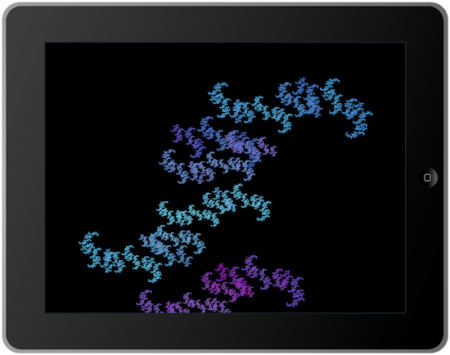Just one of many things an iPad can be.
Consult the education professors
Dear Editors,
I write regarding a recent article about education reform politics.
There is an entire discipline of professionals who study what works and what doesn’t work in education. They have done research for decades in every state and all over the world, and they largely agree about what improves student outcomes and what doesn’t. I am talking about education professors, people with PhDs studying schools, teaching, and learning.
In your lengthy article about education reform, and in the larger conversation about these issues, the people who actually know what they’re talking about — education professors — are not consulted or quoted. Instead it’s just a bunch of donors and politicians with “opinions”. Can you help us move towards a more fact-based conversation by interviewing the experts the next time you report on education reform (or really any issue)?
Robin
User Friendly
A recent thread on LinkedIn discusses how user experience professionals can answer the question “What do you do for a living?” One contributor wrote:
“I help companies make their products more user friendly.” That’s a term most people understand. If they ask follow up questions I will go into more detail.
The term “user friendly” makes me think of the nineties, as in “Mac is more user friendly than Windows.” I hesitate before using it, because as a software designer, I want to go beyond “friendly” and make interfaces that are also more powerful, more fun, more educational.
But I too have found that “user friendly” is the term that normal (non-UX) people understand. We naturally anthropomorphize computers, and want to know whether they are friendly, like a person we would choose to spend time with.
Designers create this “user experience” via methods such as “human-centered design”, “user research”, “advocating” and “interaction design”… but these are all technical terms that don’t mean much to people outside the field.
What people really want to know is whether the end product will feel like a friend.
Design is how it works
John Gruber has written an important critique of Walter Isaacson’s Steve Jobs biography. To me, the following is the most interesting core of the argument:
Prior to Jobs’s return to Apple, design was what happened at the end of the engineering process. Post-Jobs, engineering became a component of the design process. This shift made all the difference in the world.
Isaacson does not understand this.
My impression is that most technologists, journalists, analysts, and certainly the general public do not understand this either. But it is fundamental, and it is indeed the core of what I have always been most interested in doing: using engineering to solve design goals.
It’s strange that this is a point of confusion, because engineers have always been tasked with creating products that are useful for humans. Perhaps the problem is that as engineering became more complex over time, engineers increasingly focused on their subfields, analyzing the quantitative properties of materials and semiconductors, and were no longer trained in what used to be called “ergonomics.” User-centered design is really just a return to the original intention of engineering — to create technology for humans. It is a reminder that the human side of the equation is just as important as the scientific side, and that these two are intimately connected.
Gruber points out a 5-word Steve Jobs quote that Isaacson should have paid better attention to:
Design is how it works.
In Gruber’s words: “engineering should and can be part of the art of design.”
Improving at teaching
From the Gates Foundation 2012 Annual Letter:
I still find it hard to believe that 95 percent of teachers are not given specific feedback about how to improve. Even more important than a pay schedule that rewards excellence is identifying and understanding excellence so that teachers know how they can improve. In all the meetings I have had with teachers around the country, and in the surveys we have done, it is clear that most teachers want more feedback and will use it to improve, even if the financial rewards for performance are comparatively modest.
Natural
“Those who wish to protect natural ecosystems learn, to their stupefaction, that they have to work harder and harder — that is, to intervene even more, at always greater levels of detail, with ever more subtle care — to keep them ‘natural enough.'”
-Bruno Latour, in Love Your Monsters
Overqualification
“The history of the design professions is largely a history of overqualification, of men and women who have insisted on doing more than either clients or public ever asked for.”
-Ralph Caplan, By Design
The value of Apple’s innovation process
Horace Dediu makes an important argument that Apple’s stock price has been based simply on the value of its latest products, whereas “the process of product development at Apple is worth nothing.”
In other words, from the market’s perspective:
Innovations are valuable, but there is no such thing as an innovation process. If there was such a thing, then we could measure it and put a number on its value. Until then, innovation is nothing more than a spin of the roulette wheel.
Dediu’s unspoken point, of course, is that the market is missing something huge: Apple has honed and demonstrated its ability to repeatedly design, produce, and sell innovative consumer electronics products. I am absolutely convinced that their success is not due to luck but rather to a finely tuned innovation process. That doesn’t mean they will never release duds, of course, but it means that on the whole they can be counted on to continue to disrupt markets with innovative products. The wider technology community misunderstands this ability so deeply that instead of trying to copy Apple’s innovation process, they insist that it is nothing but good luck and good marketing.
How many students take Intro Statistics?
The University of Washington has about 30,000 undergraduates, about 500 of which were enrolled in introductory classes in the statistics department. Assuming that number holds every quarter, 1500/30000 = 1.6% of UW students take an intro statistics class each year.
There are 18 million college students in the United States. If the overall percentage who take statistics is the same as at UW, then about 300,000 college students take intro stats each year in this country.
Interfaces of the Future are Tactile and Manipulable
Bret Victor released a really excellent article about what is missing in the user interfaces of current technology, and what we should consider when crafting visions for the future. Compelling and easy to understand.
I call [iPad] technology Pictures Under Glass. Pictures Under Glass sacrifice all the tactile richness of working with our hands, offering instead a hokey visual facade….
We live in a three-dimensional world. Our hands are designed for moving and rotating objects in three dimensions, for picking up objects and placing them over, under, beside, and inside each other….
To me, claiming that Pictures Under Glass is the future of interaction is like claiming that black-and-white is the future of photography. It’s obviously a transitional technology. And the sooner we transition, the better.
Read the whole article, which has great pictures as well.

